Five out of 720 commercially reared monarch butterflies tagged and released at our 2017 Monarch Butterfly and Pollinator Festival in San Antonio were recovered in Mexico, citizen science organization Monarch Watch announced this week.
The five tags constitute 0.54% of the total 928 tags recovered and reported back to Monarch Watch–an exceptional number, given that an estimated 80,000 butterflies were tagged this season.
The news arrived via social media and the DPLEX List, an email list managed by Monarch Watch, the University of Kansas at Lawrence citizen science initiative and monarch butterfly conservation organization. Each year, thousands of volunteers purchase Monarch Watch tags, tag the migrating monarch butterflies in the fall, record the sex of the butterfly, and report the data back to Monarch Watch. Volunteer surrogates for the organization then visit the roosting sites in Mexico over the winter, seeking out locals to whom they pay $5 per recovered tag. Those recoveries are then returned to Monarch Watch and shared with the community.
In a follow-up email to the DPLEX list, Monarch Watch founder Chip Taylor, a guest at the Festival’s Butterflies without Borders Climate Change Symposium last year, said that 2017 tag recoveries were “quite high.”
The success story was well received in San Antonio. “So awesome!” said Chief Marketing Officer Elizabeth Fauerso of the Pearl, which hosts the Festival. Drake White, Chief Docent for the Festival, described the feat as “so cool!” “It’s such a hopeful sign that our butterflies made it,” she said.
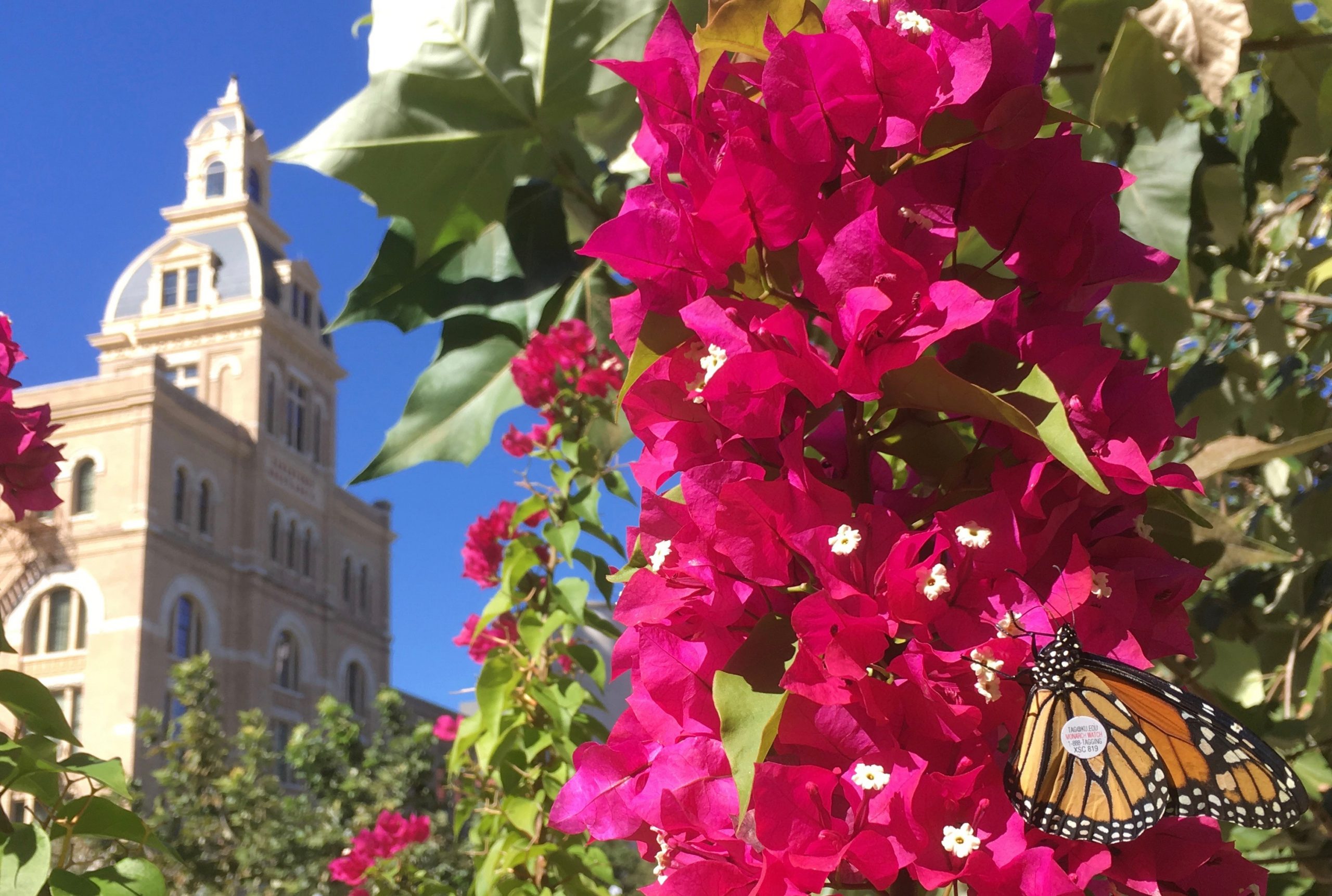
XSC819 was not recovered in Mexico, but three of his brothers and two of his sisters were. Photo by Monika Maeckle
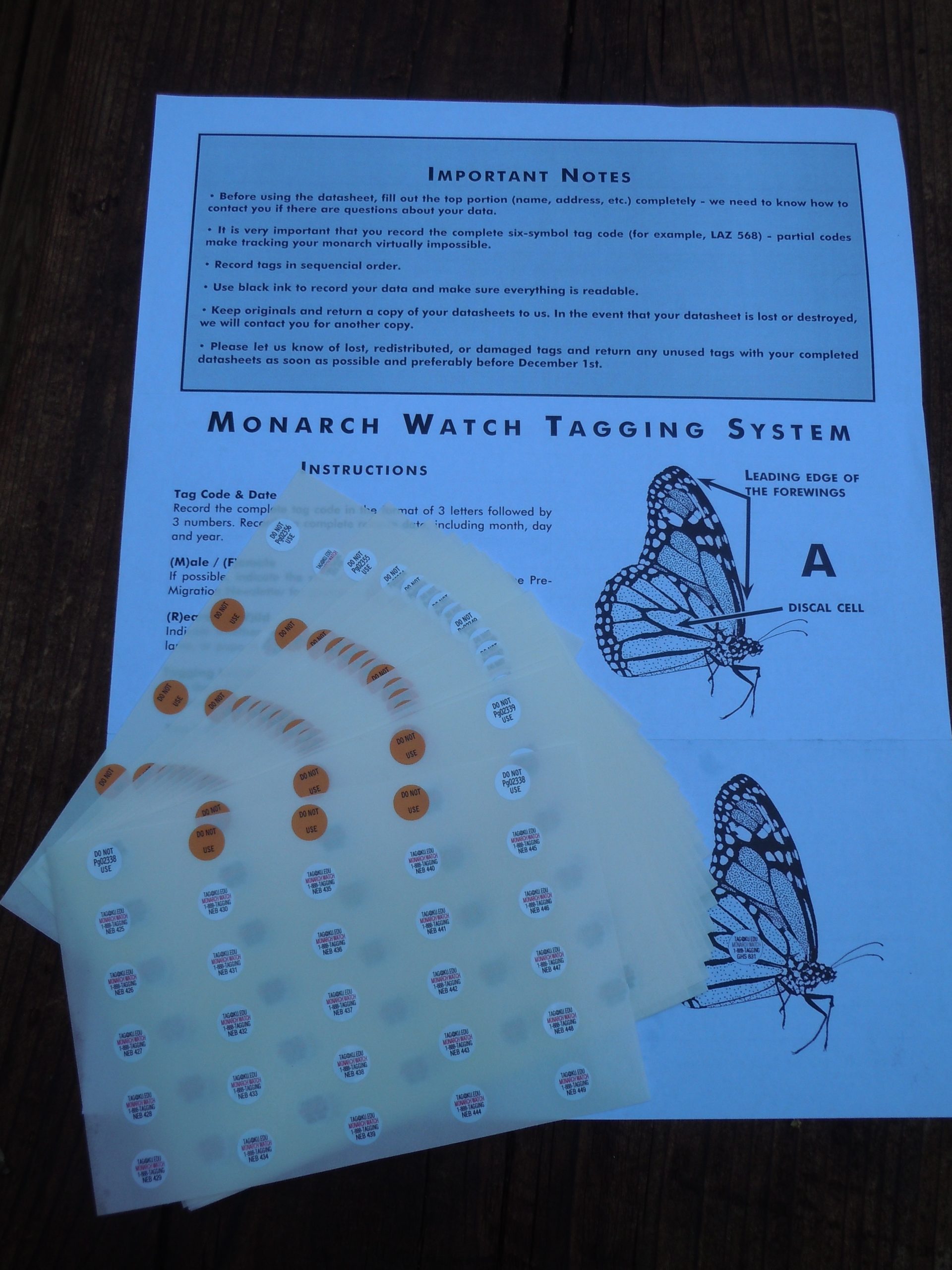
The Monarch Watch tags are coded with three letters and three numbers. Photo by Monika Maeckle
White and a team of 15 docents tagged more than 500 butterflies with the small round stickers, which were coded with the letters XSC followed by a number. The five recovered tags–two from females and three from males–were applied by small groups of visitors from 10AM – 2 PM October 22nd. Docents explained the monarch butterfly migration in general and how to tag monarchs in particular. They recorded the data and sent the butterflies off with the winds during peak monarch migration season here in the Texas Funnel. Another 220 tagged butterflies were released from the Festival’s custom-made Mariposa Pyramid, as a crowd of thousands watched in Pearl Park.
Commercially reared and tagged butterflies completing the migration to Mexico defies the conventional wisdom in the monarch butterfly world. Many in the science community contend that butterflies raised in captivity and shipped cross-country lack the Darwinian skill set to join the epic migration that unfolds each fall.
For years, scientists have asserted that coddled monarchs reared with access to infinite milkweed and protection from predators just don’t have what it takes to brave the harsh elements. While theories on how the sun’s cues, a butterfly’s geographic location, and ambient temperature affect a monarch’s ability to migrate provoke ongoing scientific debate, a general consensus exists that butterflies raised at a butterfly farm in Florida, sent by UPS to Texas and released in San Antonio will never make it to Mexico.
Anurag Agrawal, author of Monarchs and Milkweed: A Migrating Butterfly, A Poisonous Plant and their Remarkable Story of Coevolution, said he’s not surprised by the news. “I guessed it would be so,” said the monarch butterfly researcher and chemical ecologist at Cornell University, via email. “And now evidence shows that commercially reared monarchs can, and some do, successfully migrate to the Mexican overwintering grounds.”
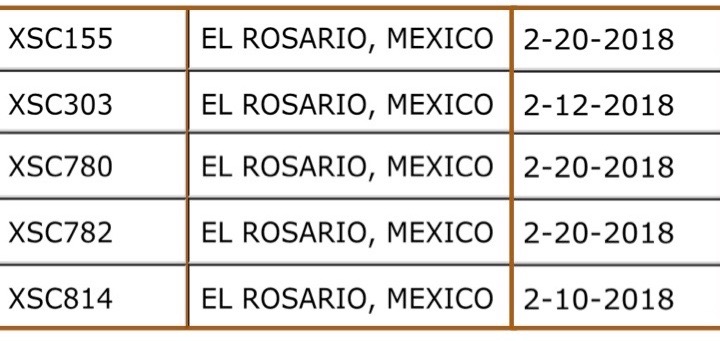
Does XSC stand for Xtra Smart Creature? We think so. The five tags above, placed on monarch butterflies at our 2017 Monarch Butterfly and Pollinator Festival, were recovered at the El Rosario Monarch Butterfly Biosphere Preserve near Angangueo, Mexico, in early 2018.
Agrawal explained that as long as caterpillars and immature butterflies receive the environmental cues of impending winter, they will attempt migration.
“Nonetheless, I don’t think this success closes the book on the controversy about commercially rearing monarchs,” he said, alluding to an ongoing contentious debate that swirls around diseases that can result from unsanitary and crowded conditions at some commercial butterfly breeding operations. “Although they only had to fly from San Antonio (still a good 800 miles!), the fact that five out of 720 made it is a high success rate…. What is their typical success rate? And, what is the typical O.e. infection [a monarch-centric spore-driven disease] rate? Those are still important questions to ask and answer.”
The butterflies purchased for our Festival were raised by Connie Hodsdon of Flutterby Gardens in Bradenton, Florida. Hodsdon prides herself on an immaculately clean operation and teaches the course on raising disease free monarchs to members of the International Butterfly Breeders Association. Her rearing scheme includes constant vigilance, lots of latex gloves, and multiple dousings of bleach for every milkweed stalk that might be noshed by a monarch caterpillar. Such standard operating procedures limit germs and the transfer of the deadly OE spores.
The San Antonio Festival tag recoveries are not the first time that commercially reared butterflies have been documented making it to Mexico. Last year, WGX139 arrived in the Mexican mountains more than a thousand miles from the Grapevine Flutterby Festival in Grapevine, Texas where it was released. It took 138 days for the tag to be recovered in the El Rosario Monarch Butterfly Biosphere Preserve in Michoacán. Hodsdon also provided that butterfly.
The recoveries beg the question of what role commercial butterfly breeding might play in helping to restore declining monarch butterfly numbers. As climate change, habitat loss and pesticide use conspire with natural obstacles like predators and diseases, it seems wise to explore all options. If commercially bred Monarch butterflies can migrate and responsible breeders can raise them disease-free, why not tap that resource to inject healthy specimens into the diminishing gene pool?
One can only hope as science debates that question.
TOP: Thousands gather at Pearl Park to enjoy the release of several hundred butterflies from the Mariposa Pyramid. Docent Drake White oversees the spectacle. Photo by Matt Buikema
Related Posts
- Commercial raised monarch butterfly released in Grapevine, TX, makes it to Mexico
- Monarch Butterfly and Pollinator Festival in San Antonio a roaring success
- How to tag a monarch butterfly in six easy steps
- Agrawal: Milkweeds don’t need Monarchs, but Monarchs need milkweed
- Q&A: Anurag Agrawal challenges Monarch conservation conventional wisdom:
- Climate change and Monarch butterfly migration symposium tackles tough questions
- How to plan a successful butterfly and pollinator garden
- Mostly native butterfly garden outperforms lawn every time
- Tropical Milkweed: To Plant it or Not is No Simple Question
- How to raise Monarch butterflies at home
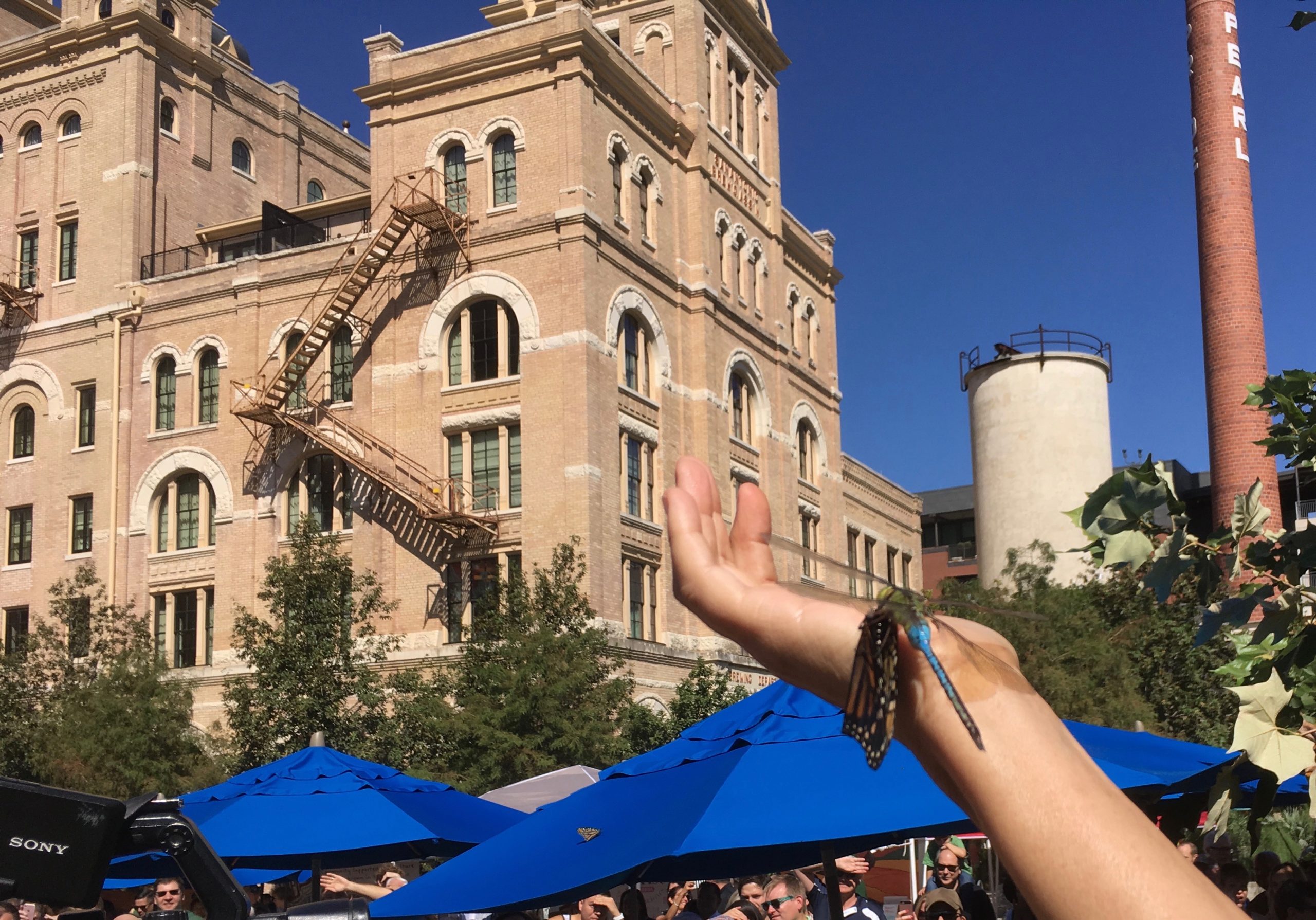
Survival of the fittest: dragonfly takes down a monarch during the mass release at the 2017 Monarch Butterfly and Pollinator Festival. Photo by Monika Maeckle
Like what you’re reading? Don’t miss a single post from the Texas Butterfly Ranch. Sign up for email delivery below, like us on Facebook, or follow us on Twitter, @monikam.

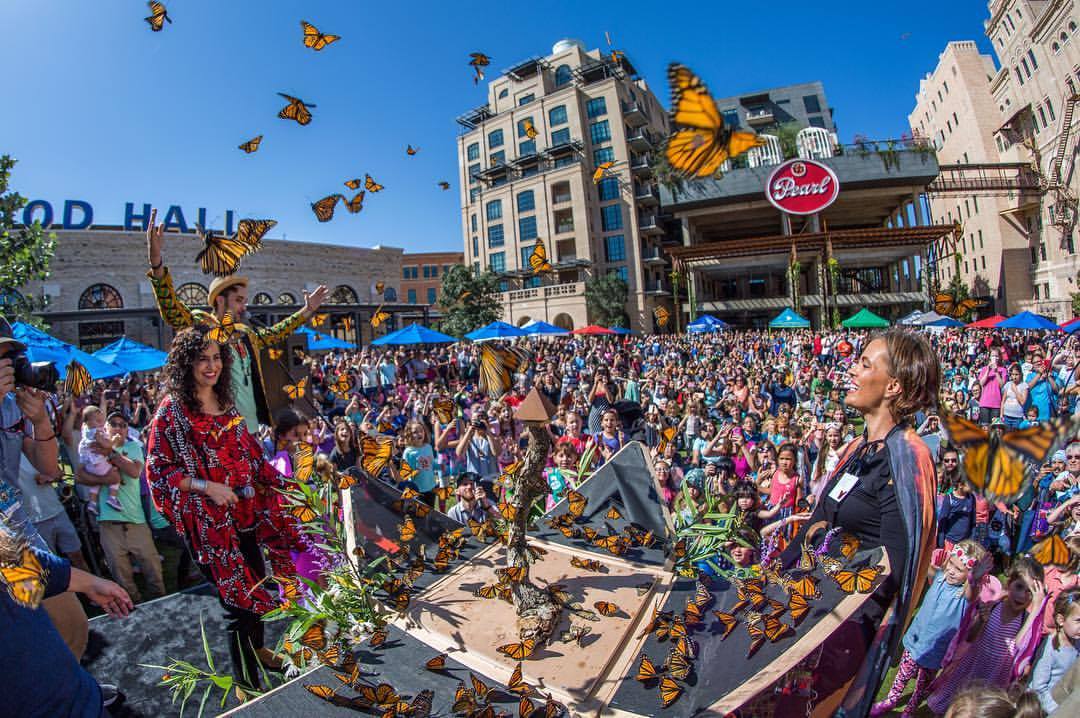
A much larger tagging study involving about 5,000 commecially raised monarchs released in the Rocky Mountain States was conducted 19 years ago and generated tag recoveries at the overwintering sites in both Mexico and California: http://www.swallowtailfarms.com/pages/educationalproducts_mms.html
[…] on the Texas Butterfly Ranch web site, 25 April, 2018 Five monarch butterflies tagged and released at San Antonio Festival made it to Mexico It took 138 days for the tag to be recovered in the El Rosario Monarch Butterfly Biosphere Preserve […]
Beautiful festival! Had no idea about the existence of this festival.
Does “de-tagging” the Monarch by the locals in Mexico kill the Monarch?
Typically the only butterflies recovered are those that have already perished. No one really “de tags” the butterflies. They are found, dead, on the forest floor. Sometimes we net tagged butterflies in the course of applying tags or observing monarchs. We release them to carry on their migration. –MM
[…] Conventional monarch butterfly science has held that butterflies raised in captivity without natural cues don’t have the Darwinian skill set to migrate. Yet the 2019 recoveries bring to eight the total number of butterflies that were reared at a Florida butterfly farm, shipped to Texas, tagged and released at the San Antonio Festival, and recovered on the forest floor in the Mexican mountains. Last spring, five butterflies tagged at the 2017 Festival were recovered. […]
[…] and wild] monarchs don’t get to Mexico.” Monarch Watch tracks butterfly migration, and recently found several monarchs, sourced from a different commercial breeder and released at a festival in San […]
[…] and wild] monarchs don’t get to Mexico.” Monarch Watch tracks butterfly migration, and recently found several monarchs, sourced from a different commercial breeder and released at a festival in San […]
[…] and wild] monarchs don’t get to Mexico.” Monarch Watch tracks butterfly migration, and recently found several monarchs, sourced from a different commercial breeder and released at a festival in San […]
[…] and wild] monarchs don’t get to Mexico.” Monarch Watch tracks butterfly migration, and recently found several monarchs, sourced from a different commercial breeder and released at a festival in San […]
[…] and wild] monarchs don’t get to Mexico.” Monarch Watch tracks butterfly migration, and recently found several monarchs, sourced from a different commercial breeder and released at a festival in San […]
[…] and wild] monarchs don’t get to Mexico.” Monarch Watch tracks butterfly migration, and recently found several monarchs, sourced from a different commercial breeder and released at a festival in San […]
That’s not to say that all captive-reared monarchs are incompetent migrators. Last year, about 700 commercially bred individuals were tagged and released at a San Antonio, Texas, festival; five of these were later found at overwintering sites in Mexico. “But there’s a population-level difference,” says Marcus Kronforst, who led the new study. “Some individuals might be able to respond correctly, but most do not.”